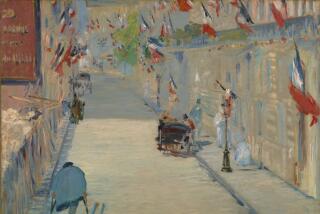WILSHIRE CENTER
As director of the G. Ray Hawkins Gallery, David Fahey proved himself an unusually gracious and knowledgeable art dealer. Now in partnership with Randee Klein, Fahey opens a new gallery with a provocative exhibition schedule that promises to kick up some controversy; the inaugural show of New York artist Izhar Patkin is certainly a sassy choice.
A series of bright, brassy paintings installed with titles stenciled on the wall in big colored letters, the show is engorged with the mood of the moment. Anxious meditations on systems of knowledge and sensuality that put one in mind of Proust, Patkins’ paintings do for China (the alleged theme here) what “Jewel in the Crown” did for India; they encrust it with pasteboard diamonds and embalm it. There’s an attractive glitter to Patkin’s rococo work, but a devastating sense of emotional displacement lurks just beneath its surface. The pictures are pretty, yes, but there’s something cheap and insincere about them. That was, no doubt, the point.
Combining kitsch materials (velvet, gold leaf) and industrial goods (wire-mesh screening), Patkin’s work looks for all practical purposes like Bad Painting, a Post-Modern school that’s laudable for the way it spits in the eye of Formalist convention, but is nonetheless rather hard to look at. Patkin has a lurid sense of color and his images of geishas, teapots and flowers are virtually aflame. However, he intends that his work do more than simply swamp the eye with color. A narrative thread runs through his work (an installation included in the current Whitney Biennial is based on a Genet play), and in fact the idea of narrative is central to Patkin’s aesthetic. Being a dutiful Post-Modernist he naturally takes a new tack on an old theme; Patkin’s idea is to present narrative in such a way that images don’t illustrate an already existing story so much as they function as signposts that mark out the parameters of a potential--as yet unwritten--story. The viewer is invited to connect the dots as he sees fit.
An egalitarian notion that, but check out all the other stuff going on in Patkin’s work and you realize he’s not playing to plebes in the back row. There is, for starters, the mystifyingly complex method Patkin employs to make his paintings; he paints in reverse, forcing pigment through the back of a screen so the surfaces of his pictures are alive with thousands of tiny paint tentacles. Not just one layer of paint mind you, but graduated layers of paint, shading, highlights, the works--all figured out in reverse. The technique seems a pointless affectation considering that the resulting pictures have a mass-produced, paint-by-numbers look. Then take note of the fact that as is evidenced by this year’s Whitney Biennial, art incorporating words (remember Patkin stencils his on the wall) is currently a hot gimmick, and this work begins to look alarmingly trendy--which is to say, it looks exactly the way art is supposed to look right now: strident and artificial, too smart to believe in much of anything, least of all art history. It’s a rather sad show that will no doubt sell like hot cakes. (Fahey/Klein, 148 N. La Brea Ave., to June 20.)
More to Read
The biggest entertainment stories
Get our big stories about Hollywood, film, television, music, arts, culture and more right in your inbox as soon as they publish.
You may occasionally receive promotional content from the Los Angeles Times.










